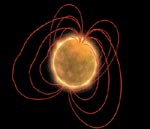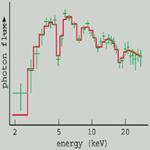| Extended Reading Material | |||||||||||
|
Strongest magnet
in the cosmos In November 1996 a NASA satellite called the Rossi X-ray Timing Explorer (RXTE) was monitoring a rare type of pulsar some 40 000 light-years from Earth. The star, called SGR 1806-20, is one of just four known "soft gamma repeaters" -- rotating neutron stars that periodically emit huge bursts of gamma rays. Now an international team of astrophysicists studying the RXTE data has found evidence for what is known as a magnetar -- the most magnetic object in the universe. Pulsars are rotating neutron stars that appear as giant cosmic lighthouses. With about one and a half solar masses squeezed into a sphere with a radius of 10 km, neutron stars are the densest objects known. The rotation can give rise to a clock-like radio signal, in which case the star appears as a pulsar. The basic pulsar model involves a magnetic dipole field tilted with respect to the rotation axis, beaming radio waves along the dipole axis as the star spins.
The electromagnetic emission from a pulsar comes at the expense of a loss of rotational energy, which causes its rate of rotation to decrease, or spin down, and enables us to measure the magnetic field. The spin-down rate is only about a millionth of a second over 100 years, but it can be measured with high accuracy in the radio region of the electromagnetic spectrum. Assuming a simple dipole model, the spin-down rate is proportional to B2/P, where P is the star's rotation period and B is its magnetic field. In some cases the magnetic field can be measured directly, and this is the technique used in the recent interpretations of the RXTE observations. However, the relationship between spin-down rate and magneto-dipole losses is not as straightforward for pulsars that also emit X-rays. But there is a way round this. In a strong magnetic field, electrons are forced to move along the field lines, but when magnetic confinement squeezes the electron in the transverse direction to less than its de Broglie wavelength then quantum effects become important. The transverse motion becomes quantized with discrete energy levels the Landau levels. A direct measure of the star's magnetic field is therefore obtained by detecting an emission line at the frequency of electrons making a transition between the Landau levels. Typically these spectral lines are visible in the hard X-ray region: for example the electron cyclotron line for the pulsar in the binary system Hercules X-1 is at about 60 keV. Neutron stars are now known to possess very intense magnetic fields, of the order of 100 million tesla, which is about six orders of magnitude greater than the strongest magnetic field in an ordinary star or that can be produced in a laboratory. But actually explaining the magnetic fields found in pulsars is a big challenge for theoretical astrophysicists. Ten years ago Robert Duncan from the University of Texas and Christopher Thompson from the University of North Carolina showed that during the formation of a neutron star, convective motions combined with fast rotation give rise to fields of up to 100 billion tesla. They dubbed neutron stars with such enormous fields "magnetars", and astronomers immediately began to search for them. Hunting magnetars The first magnetar candidates were a family of rare and peculiar galactic sources of gamma and X-rays called soft gamma repeaters (SGRs). These slowly rotating pulsars glow quietly in the X-ray region for several years and then suddenly become vigorously active for a period of a few weeks to months. During this phase they emit hundreds of short (~0.1 s) bursts of soft gamma rays, each with luminosities up to a billion times greater than that of the Sun. These bursts suggest that SGRs may contain a magnetar. The theory is that as the magnetar's colossal magnetic field drifts through the solid crust of the star, it might stress and sometimes crack the crust to produce what are known as starquakes. During a starquake the magnetic field becomes unstable and abruptly rearranges itself into a state of lower energy. Violent seismic waves wrinkle the star crust, producing a displacement in the footprints of the magnetic field. The field lines can act like stretched strings, generating elastic-type waves called Alfven waves, which in turn accelerate clouds of particles above the surface of the star. This is what ultimately produces the gamma-ray bursts. If this interpretation is correct, then the burst activity of SGRs is somewhat similar to solar flares, but with a far larger energy release. In both cases it is the displacement in the footprints of the magnetic field (due to strong convection in the Sun and to seismic activity in the neutron star) that triggers the generation of Alfven waves. Magnetars, much as ordinary radio pulsars, are expected to spin down. However, given that the field strength of a magnetar is 1000 times greater, the spin-down rate is now substantial -- about a millisecond per year. In the late 1990s a team led by Chrissa Kouveliotou of NASA's Marshall Space Flight Center and Kevin Hurley of the University of California at Berkeley succeeded in measuring a spin-down rate in this range for two SGRs. This was a major breakthrough that greatly strengthened the arguments in favour of the magnetar scenario for SGRs. Despite strong indirect evidence, however, definite proof of the existence of magnetars was still missing. Astronomers needed to be able to measure the magnetic field directly, by detecting the electron cyclotron line. But for a field of 100 billion tesla, the electron emission energy is a few tens of MeV -- a region that is spectroscopically inaccessible to current space missions. However, for such high magnetic fields the proton cyclotron line, normally hidden in the highly absorbed optical/UV region, is expected to show up at energies of a few keV. Theorists, including Dong Lai and Winn Ho from Cornell University, along with the present authors, started to determine the properties of the radiation field. This field permeates the strongly magnetized plasma under the extreme conditions that are thought to exist near the surface of a neutron star. Our aim was to predict the properties of the spectral line, such as its intensity and width. We concluded that proton cyclotron lines would appear as absorption features, broad enough to be resolved using current X-ray observatories. Astronomers thus started a concerted campaign to search for proton cyclotron features in all known magnetar candidates. Until now, however, no convincing detection has been reported from observations of the sources during their quiescent phase, that is when they are not active. Data bursts in The new results are based on observations from the RXTE satellite of SGR 1806-20 while it was exhibiting intense bursting behaviour during November 1996. The satellite is mainly devoted to the study of the time variability of X-ray sources and it is not equipped with a proper X-ray spectrograph. However, it does carry a detector called the Proportional Counter Array (PCA) that can discriminate between photons with energies from about 260 keV. The PCA energy resolution is not very high (it can distinguish between photons with energies 20% apart) but this is good enough to produce a plot of the number of collected photons as a function of their energy.
The importance of this detection goes beyond just adding a new entry in the zoo of star characters. It is the first detection ever of a proton cyclotron feature in a cosmic source. Moreover, it unequivocally establishes the magnetar nature of soft gamma repeaters and provides a clear demonstration of the existence of magnetic fields substantially higher than the quantum critical value (4.4 billion tesla). This is the value at which the energy gap between the first and the second Landau level is comparable to the rest mass of the electron. At this field strength, the magnetic confinement is so strong that the space available for an electron in the transverse plane is comparable to its de Broglie wavelength. This is the smallest spatial region within which an electron can be localized, and the value of the quantum critical field therefore has crucial significance as the natural quantum measure of field strength. This discovery represents a new frontier in neutron-star astrophysics. Since magnetars slow down rapidly, only a handful of them will be active and observable at any one time. Even so, astronomers expect the number of detections will increase rapidly in the near future. A conservative estimate puts the number of magnetars formed in our galaxy at about one million, but there could equally be between 30 and 100 million. Their detection is therefore only just beginning. Author
|
|||||||||||
|
|
|||||||||||
| _____________________________________________________________ |
|||||||||||
 Measuring
high magnetic fields
Measuring
high magnetic fields In
2002 Alaa Ibrahim from George Washington University, a team from NASA's
Goddard Space Flight Center, and the present authors, found a peculiar
feature in the X-ray energy spectrum of SGR 1806-20. First this appeared
in a single burst (Ibrahim et al. 2002 arXiv.org/abs/astro-ph/0210513)
and then in many other events (Ibrahim et al. 2002 arXiv.org/abs/astro-ph/0210515).
The observations led to a direct measurement of the magnetic field,
thereby confirming the magnetar structure of SGRs. In a narrow energy
range centred on 5 keV, the number of photons was less than that found
at other comparable energies (see figure). The energy and width of this
absorption feature are typical of the absorption of electromagnetic
radiation by a proton gyrating in a magnetic field of about 100 billion
tesla.
In
2002 Alaa Ibrahim from George Washington University, a team from NASA's
Goddard Space Flight Center, and the present authors, found a peculiar
feature in the X-ray energy spectrum of SGR 1806-20. First this appeared
in a single burst (Ibrahim et al. 2002 arXiv.org/abs/astro-ph/0210513)
and then in many other events (Ibrahim et al. 2002 arXiv.org/abs/astro-ph/0210515).
The observations led to a direct measurement of the magnetic field,
thereby confirming the magnetar structure of SGRs. In a narrow energy
range centred on 5 keV, the number of photons was less than that found
at other comparable energies (see figure). The energy and width of this
absorption feature are typical of the absorption of electromagnetic
radiation by a proton gyrating in a magnetic field of about 100 billion
tesla.